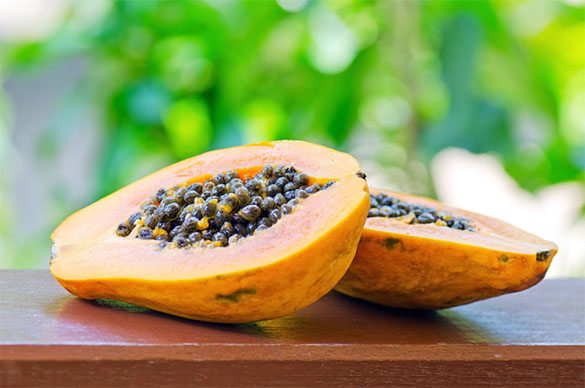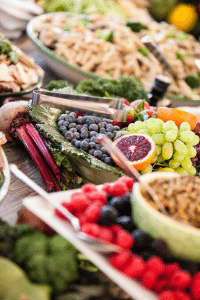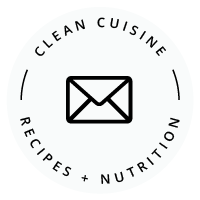
- Clean Cuisine’s Best Anti-Inflammatory Diet Secrets
- Power Up on Phytonutrients
- YOU NEED TO EAT A LOT MORE FRUITS & VEGETABLES THAN YOU THINK!
- Anti-Inflammatory Diet Secret #2
- Go Easy on Animal Protein
- Anti-Inflammatory Diet Secret #3
- Balance Your Omega-3 /Omega-6 Ratio
- Anti-Inflammatory Diet Secret #4
- Don’t Be Afraid of “Whole” Carbs
More and more, the benefits of anti-inflammatory diet “superfoods” are starting to make news headlines. It seems as though every week or so a new study appears touting why we should eat more bromelain-rich papaya and omega-3 rich wild salmon or how we might want to consider swapping our water bottles for green tea. However, it is important to understand that no one single anti-inflammatory food is going to do the mighty tough job of reducing systemic inflammation throughout your entire body or magically melt the pounds. To reduce systemic inflammation and lose body fat (simply losing weight will reduce inflammation by the way) you need an organized plan of attack, a plan that encompasses a complete anti-inflammatory lifestyle approach that includes an anti-inflammatory diet, nutritional supplementation, exercise, stress management and so on. In our book, Clean Cuisine: An 8-Week Anti-Inflammatory Nutrition Program that Will Change the Way You Age, Look & Feel (Penguin, 2013), we provide a detailed blueprint of exactly what you need to change in your lifestyle over the course of 56 days in order to dramatically reduce inflammation in your body. However, among the most important steps you can make to reduce inflammation and lose weight boil down to just four simple anti-inflammatory diet secrets…
Clean Cuisine’s Best Anti-Inflammatory Diet Secrets
We shared our top four anti-inflammatory diet secrets on NBC’s Charlotte Today morning show (you can watch the segment in the video clip above), but unfortunately our air time was very limited and we didn’t even get a chance to mention anti-inflammatory diet tip #4! Although we go into much more detail on these anti-inflammatory diet guidelines in our Clean Cuisine book, here is the Cliffs Note version of what you need to know:
Anti-Inflammatory Diet Secret #1
Power Up on Phytonutrients
Fruits and vegetables are one of the very best anti-aging, anti-inflammatory foods on the planet. They are also the very best foods for weight loss. If you check out our Clean Cuisine Anti-Inflammatory Diet Food Pyramid, you’ll see the foundation of the pyramid–meaning the foods that should make up the biggest portion of your daily diet are fruits and vegetables.
YOU NEED TO EAT A LOT MORE FRUITS & VEGETABLES THAN YOU THINK!
Did you know the Centers for Disease Control and Prevention, the National Cancer Institute, the American Heart Association and the United States Department of Agriculture all recommend adults eat at least 7 to 13 servings of fruits and vegetables every day? That’s a whole lot more than the average person even comes close to eating!
In fact, statistics show that excluding potatoes, Americans only consume about 5 percent of their calories from fruits and vegetables (1) Not eating enough fruits and vegetables is actually one of the single biggest nutrition mistakes people make. And yet throughout every epidemiological study, one of the most consistent findings in the nutritional literature is that as fruit and vegetable consumption increases in the diet, chronic disease and premature deaths decline. Dress sizes and waistlines also diminish with increased fruit and vegetable consumption. Did you know that if you did nothing more to change your diet other than simply add a lot more fruits and vegetables you would start to see the number on the scale go down? How could that be? That’s because fruits and vegetables fill nutrient gaps that often lead to food cravings. Fruits and vegetables also take up a lot of bulk and space in your stomach—so they work mechanically to keep you feeling full and satisfied.
In our Clean Cuisine book we include a number of different ways to easily and deliciously increase your fruit and vegetable daily quota, including adding the supergreen smoothie idea we share in the video link above. Click HERE for two delicious supergreen smoothie recipes you can try and start increasing your fruit and vegetable intake today!
Anti-Inflammatory Diet Secret #2
Go Easy on Animal Protein
Regardless of what certain diet gurus and fitness trainers would like you to believe, protein is not a free food. If you eat more protein than your body needs, the extra protein doesn’t just magically evaporate into thin air; it gets stored as body fat. That means the protein calories in that extra piece of chicken don’t just vanish. Eat too many skinless chicken breasts or too much whey protein powder or too many egg whites, and your jeans can soon be too tight. Eating more protein (or any other macronutrient for that matter!) than your body needs will also accelerate the aging process by increasing oxidative stress, which increases inflammation in your body.
Although many people are no doubt confused about the facts on protein, if you took a random poll picking any John or Jane Doe off the street, that person would tell you protein and animal foods such as beef and chicken go hand in hand. This means if you are eating a diet high in protein you are most likely eating a diet rich in animal foods. One of the problems with an animal-food-rich, protein-packed diet is that your stomach can hold only so much food in one day; if you are filling up on animal foods, you are basically just pushing all the other phytonutrient-rich, anti-inflammatory and disease-fighting plant foods such as fruits, vegetables, whole grains, beans, nuts, seeds, and avocados right off your plate. People aren’t eating nearly enough unrefined whole plant foods as it is, so the last thing they need is to displace plant foods with large portions of protein-packed beef, chicken, milk, and protein shakes. We don’t need more protein, people! What we really need to be eating are more unrefined plant-based foods. Plant foods are the foods we are deficient in; we are not deficient in skinless chicken breasts.
Keep in mind, protein-packed animal foods contain none of the phytonutrients found in plant foods that are essential for reducing inflammation, lowering body fat, preventing DNA damage, helping us stay youthful, and protecting against disease. In addition, animal foods are lacking in important anti-inflammatory substances that protect against cancer and heart attack, including fiber and phytonutrients, and they are rich in substances that are directly associated with degenerative diseases, such as saturated fat.
It’s not that animal foods don’t come packaged with other nutrients that are absolutely essential, such as the omega-3 EPA and DHA found in fish, the vitamin D in eggs, or the vitamin B12 found in all animal foods. These are all very important nutrients that are pretty much impossible to get adequate amounts of if you don’t eat some animal foods or take supplements. But you do not need to be eating animal foods just to get enough protein.
Watch our Charlotte Today show segment in the video above to learn more about how much protein you need each day and why animal protein will never ever be as “clean” an option as a plant protein (such as beans, nuts, seeds, “whole” soy, etc.)
Anti-Inflammatory Diet Secret #3
Balance Your Omega-3 /Omega-6 Ratio
When you are trying to reduce inflammation within your body and lose weight it is of utmost importance to optimize your ratio of omega-3 to omega-6 essential fats. Your body actually needs slightly more omega-6 fats than omega-3 fats with the ideal ratio being about 2:1 or 4:1. However, when you eat excessive amounts of omega-6 fat it pushes your body towards a chronic inflammatory state and also makes your body less sensitive to insulin, which promotes fat storage and increases the risk of obesity and type 2 diabetes.
The average person eating the modern day diet eats a very pro-inflammatory and totally out-of-whack omega-3 to omega-6 ratio of somewhere between 14:1 or 20:1. This is a big problem because eating an unbalanced ratio of omega-6 fat relative to omega-3 fat not only increases inflammation and worsens the symptoms of any inflammatory condition (multiple sclerosis, asthma, allergies, fibromyalgia, arthritis, eczema, psoriasis, Crohn’s disease, etc.) but also increases the risk of cancer and heart disease.
One of the big reasons the average person consumes such an unhealthy ratio of omega-3 to omega-6 fat is because of their over reliance on omega-6 rich processed vegetable oils. Omega-6 rich oils are ubiquitous in the processed and packaged food world as they are found in baked goods, frozen items, cereals, crackers, energy bars, salad dressings, and so forth. And now that consumers have become so savvy about the dangers of trans fats, food manufacturers have begun replacing one bad boy fat with another; instead of your favorite brand of crackers being made with partially hydrogenated oil it is more likely than not that if you read the ingredients list on the back of the cracker package it is now sporting a “trans fat free” (but also not healthy!) processed vegetable oil.
In addition to omega-6 rich vegetable oils being used in excess in processed foods, they are also used with a heavy hand in home kitchens. Those bottles of “pure” vegetable oil and corn oil are loaded with highly refined and highly inflammatory omega-6 rich fats and should not be used as part of an anti-inflammatory diet. Plus, because they are in oil form they are very easy to over-consume. It is a whole lot easier to eat 100 calories of omega-6 fat from corn oil than it is to get 100 calories of omega-6 fat from “whole food” corn!
Watch our Charlotte Today Show segment in the video above to learn the four easy things you can do today to start optimizing your omega-3/ omega-6 ratio to reduce systemic inflammation and lose weight.
Anti-Inflammatory Diet Secret #4
Don’t Be Afraid of “Whole” Carbs
And finally, the guideline we never got the chance to share on Charlotte Today; Don’t be afraid of “whole” carbs! “Whole” carbs are the carbs that come packaged the way nature intended you know, corn on the cob not cornflakes, steel cut oats not granola bars that are “made with oats”, real apples not packaged applesauce with no skin and added sugar.
The problem with carbs is not the carbs, it’s the processing! Carbohydrates are your body’s cleanest burning fuel and the vast majority of your calories on the anti-inflammatory Clean Cuisine diet come from unrefined carbohydrates in the form of fruits, vegetables, whole grains, beans, legumes, potatoes (yes! Potatoes are allowed!), etc.
Many of the “whole” carbohydrates we recommend including foods like potatoes, bananas, lentils, peas, barley, oatmeal and sprouted whole grain bread—contain a special miracle weight loss substance called “resistant starch”. Considered a functional fiber, resistant starch actually resists digestion, meaning the calories in resistant starch are much less likely than the calories in other foods (like skinless chicken breasts and vegetable oil!) to be stored as fat. And because resistant starches such as those found in the “whole” carb foods mentioned above are only partially digested yet are even more filling than simple starches like sugar and flour (which are completely digested), you end up with lower blood sugar levels, fewer insulin spikes, and a better ability to burn fat after a resistant starch–rich meal. In other words, you feel like you’ve eaten more due to the taste and volume satisfaction resistant starch brings, but your body treats these foods as if you’ve eaten less because only a small portion of the food is metabolized. If your body needs more energy than can be absorbed from the resistant starch it has no choice but to burn fat!
Studies show a diet rich in resistant starch not only helps control blood sugar levels and reduce fat storage after meals but also helps you feel more full, so you eat less. By promoting a sensation of fullness or satiety, improving your body’s sensitivity to insulin, and increasing the breakdown of fat, resistant starch from plant-based whole carbs is an essential component to losing weight without feeling hungry.
Not only will resistant starch help you shed pounds but it can improve your health in many additional ways. Resistant starch helps heart health by binding to dietary cholesterol and removing it from the body, thus lowering serum (blood) cholesterol levels. Diets rich in resistant starch also help remove toxins from your body and can lower the risk for colon cancer. And, finally, because resistant starch is a prebiotic fiber that pro¬motes good bacteria and suppresses bad bacteria, it can help normalize bowel function and support a healthy digestive system in general. Having more good-for-you bacteria in your digestive system will also improve your immune function and make it easier for your body to fight disease.
To get started reducing inflammation and losing weight check out the 8 week program in our Clean Cuisine book (Penguin, 2013).







